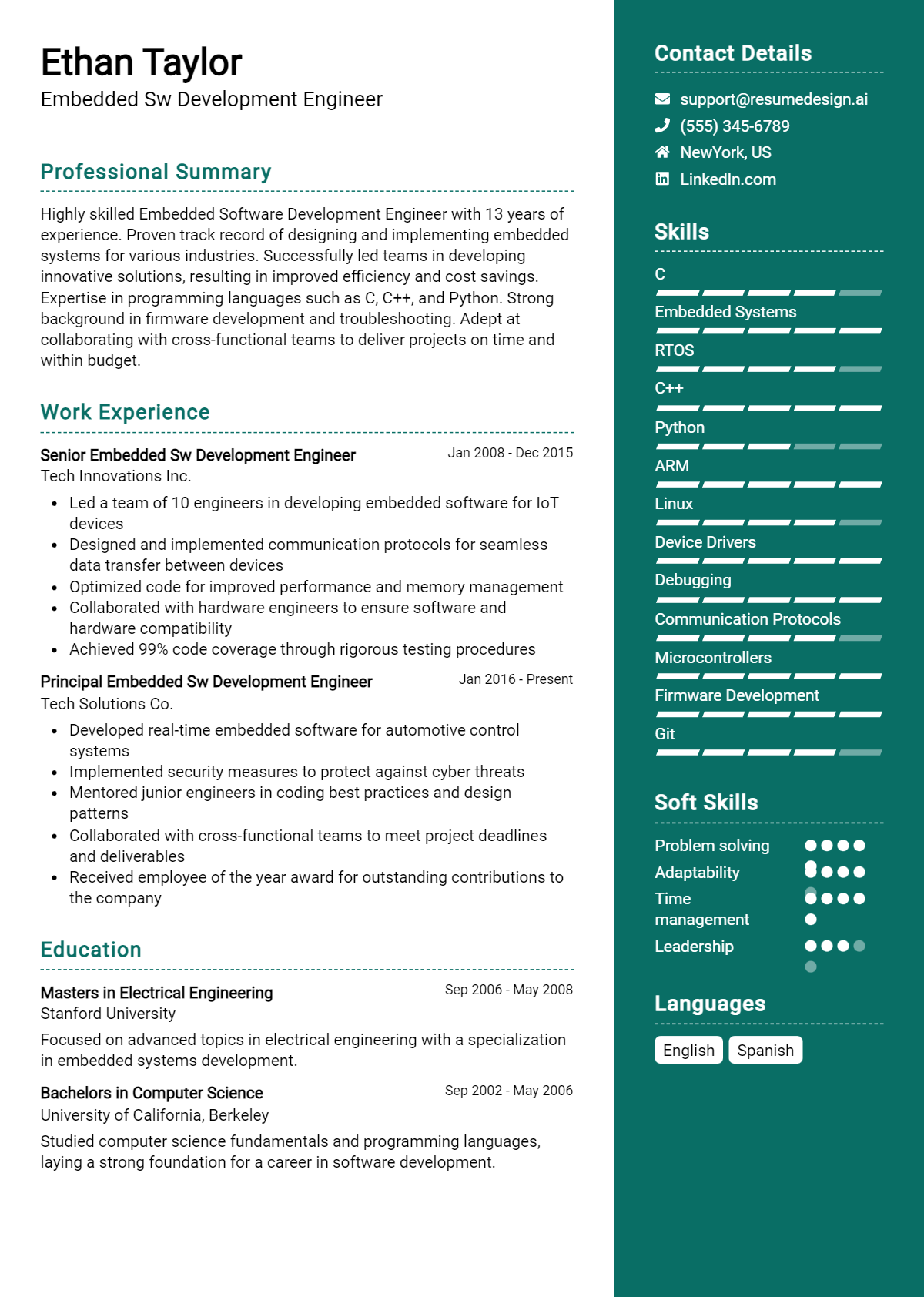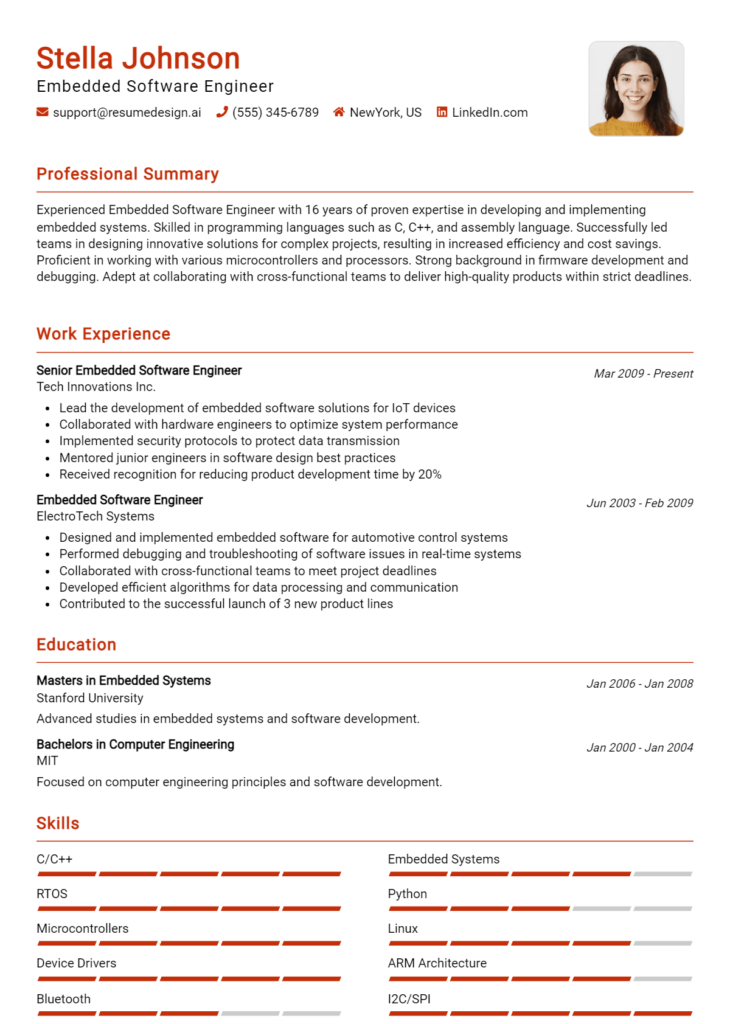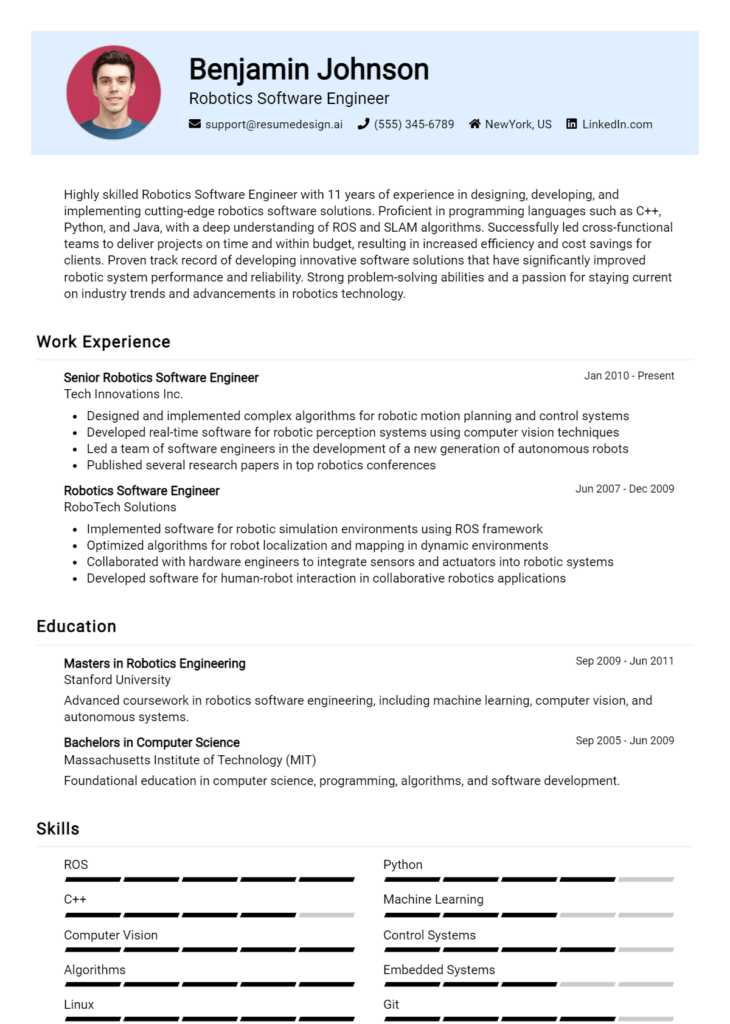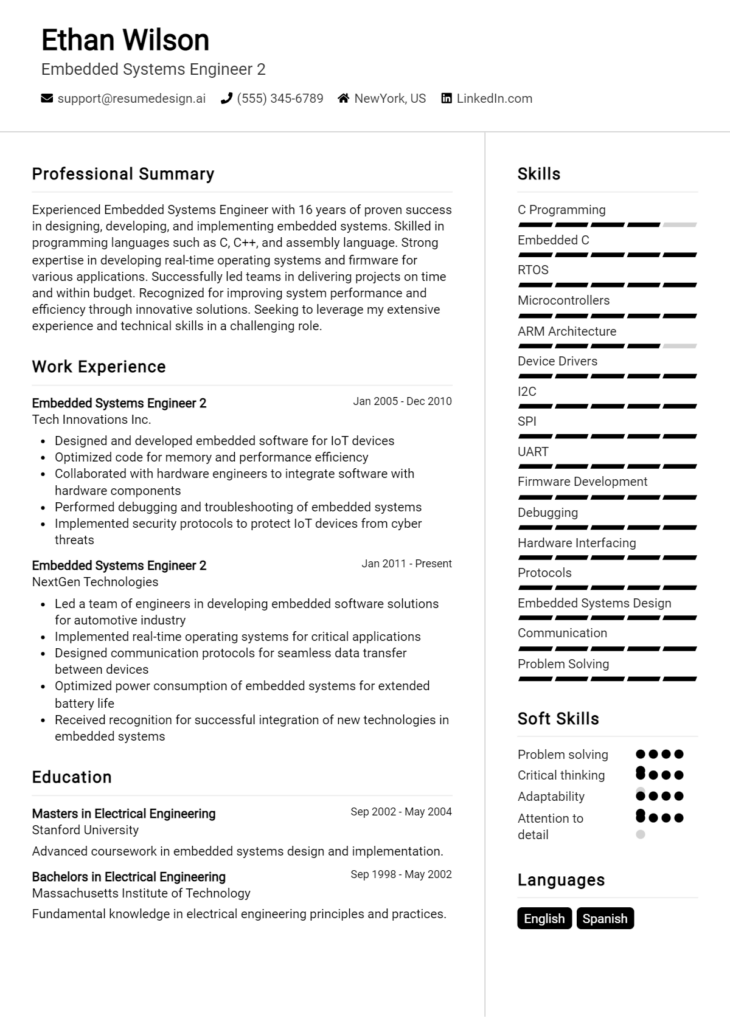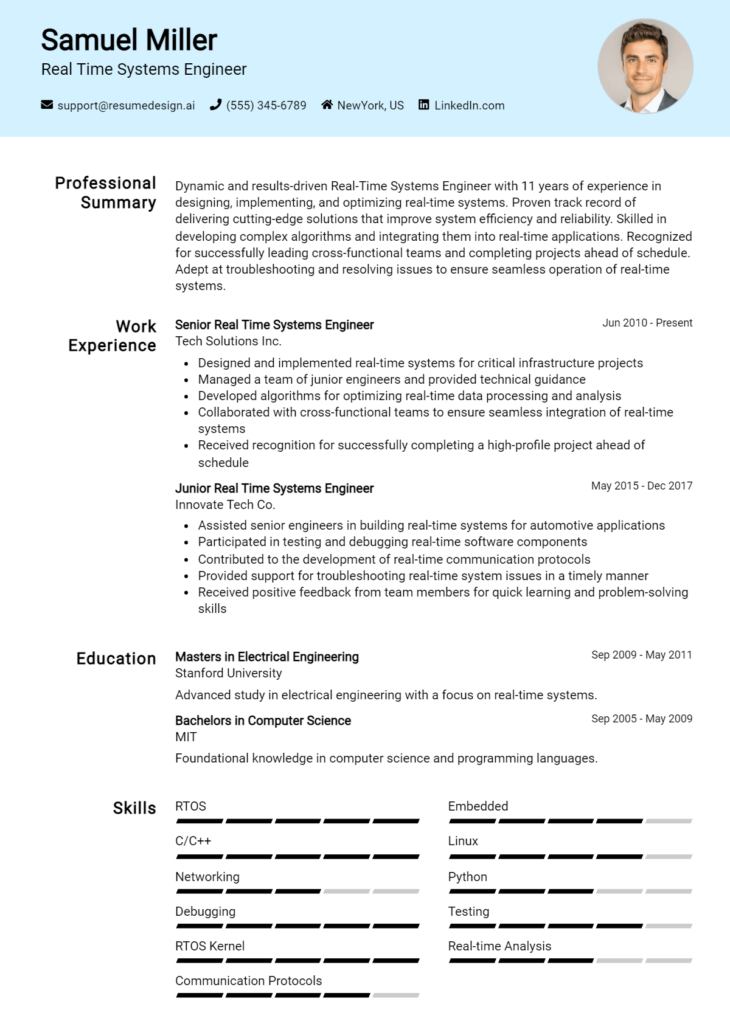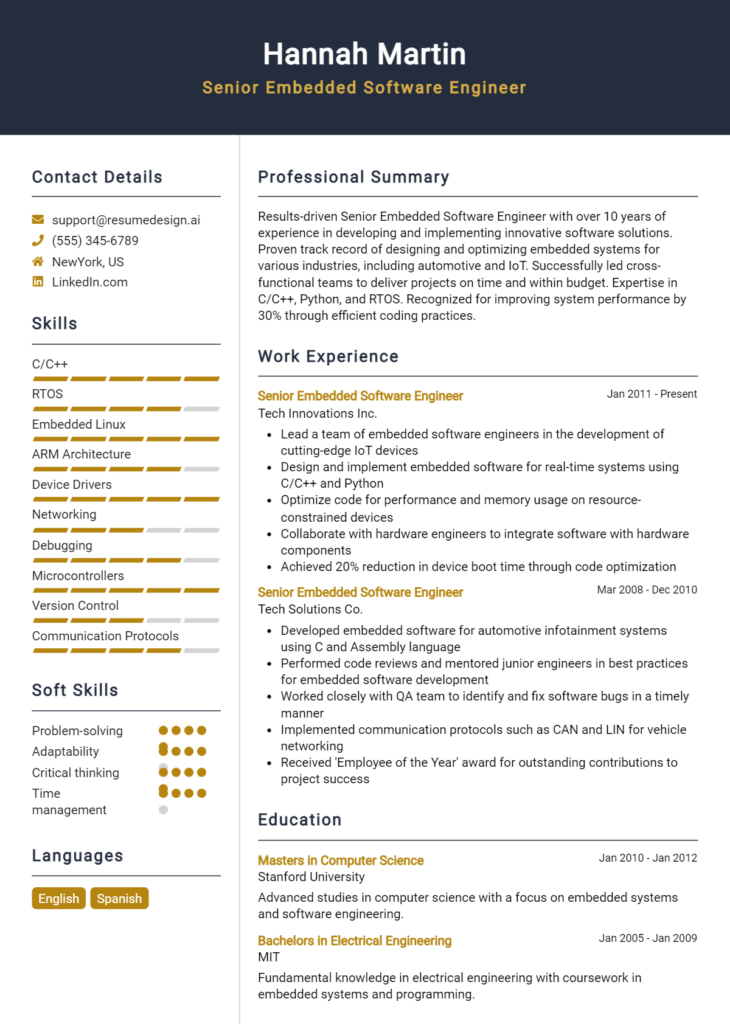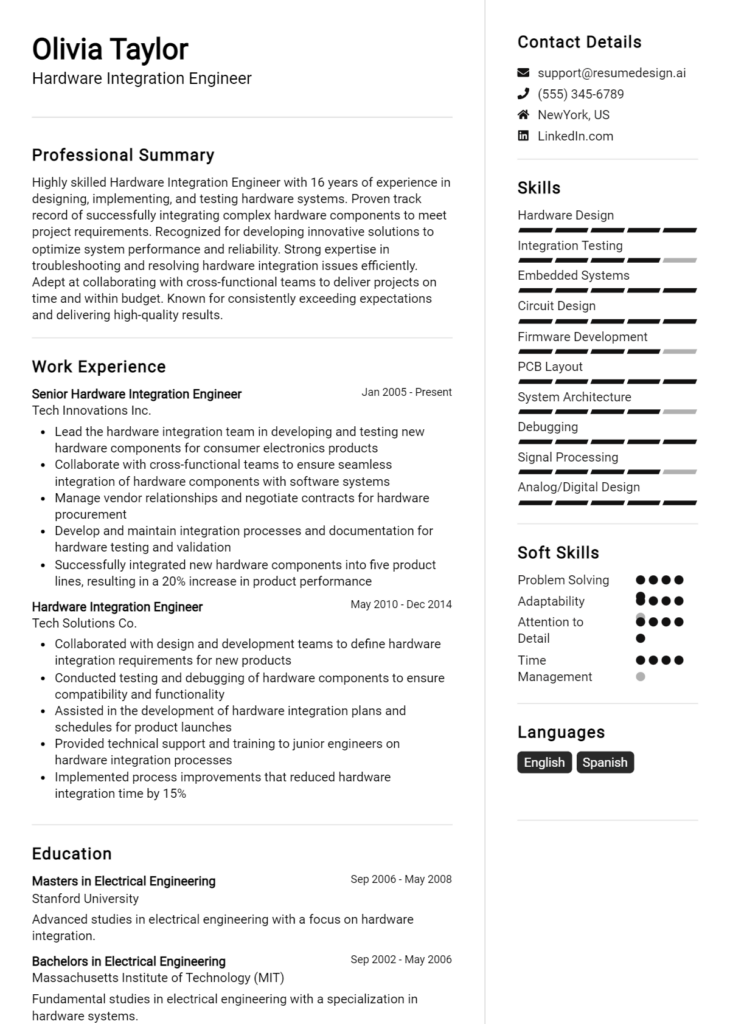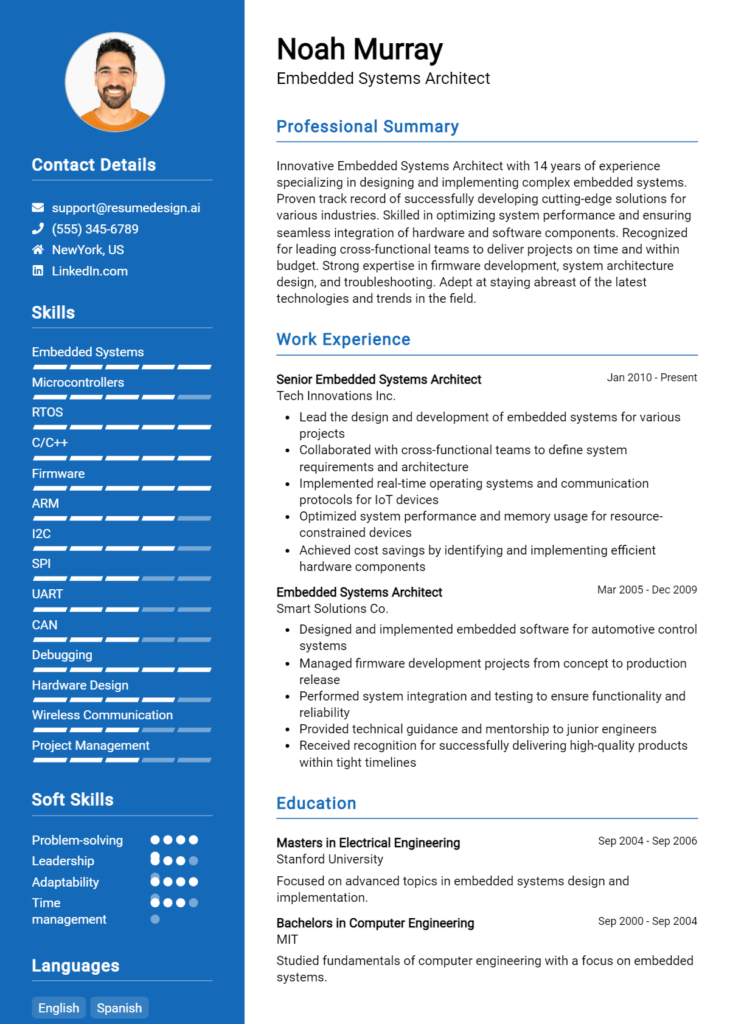Embedded SW Development Engineer Core Responsibilities
An Embedded Software Development Engineer plays a crucial role in designing, developing, and optimizing software solutions for embedded systems. This role requires strong technical skills in programming languages like C/C++, along with operational knowledge of hardware-software integration. Effective problem-solving abilities are essential for troubleshooting and enhancing system performance. By bridging engineering, product management, and quality assurance, these professionals contribute significantly to the organization's objectives. A well-structured resume effectively highlights these qualifications, showcasing the candidate's value to potential employers.
Common Responsibilities Listed on Embedded SW Development Engineer Resume
- Design, develop, and test embedded software applications.
- Collaborate with cross-functional teams to define software requirements.
- Optimize existing code for performance and efficiency.
- Conduct system-level troubleshooting and debugging.
- Implement software development best practices and methodologies.
- Document software designs, processes, and test results.
- Participate in code reviews and provide constructive feedback.
- Integrate software with hardware components and peripherals.
- Stay updated with industry trends and emerging technologies.
- Support product lifecycle management and maintenance activities.
- Ensure compliance with safety and quality standards.
- Develop and execute test plans for software validation.
High-Level Resume Tips for Embedded SW Development Engineer Professionals
A well-crafted resume is crucial for Embedded SW Development Engineer professionals seeking to make a strong first impression on potential employers. In a competitive job market, your resume serves as your first opportunity to showcase not just your technical skills but also your achievements and the unique value you bring to the table. It is essential that your resume effectively reflects your expertise in embedded systems, software development, and related technologies. This guide will provide practical and actionable resume tips specifically tailored for Embedded SW Development Engineer professionals, helping you to present your qualifications in the most compelling way.
Top Resume Tips for Embedded SW Development Engineer Professionals
- Tailor your resume to each job description by incorporating relevant keywords and phrases from the posting.
- Highlight your technical skills prominently, focusing on programming languages, tools, and technologies specific to embedded systems.
- Showcase relevant experience by detailing your roles in previous projects, including the types of systems you worked on and the outcomes achieved.
- Quantify your achievements with specific metrics, such as performance improvements, cost savings, or successful project completions.
- Include projects that demonstrate your problem-solving abilities and creativity in embedded software development.
- Emphasize your familiarity with industry standards and protocols, such as ISO 26262, AUTOSAR, or MISRA C.
- Utilize a clean, professional layout that enhances readability and allows key information to stand out.
- Incorporate certifications or relevant coursework that validate your expertise in embedded systems and software engineering.
- Consider adding a summary statement at the top of your resume that encapsulates your experience and career goals.
- Proofread for errors and ensure consistency in formatting to present a polished and professional document.
By implementing these tips, you can significantly increase your chances of landing a job in the Embedded SW Development Engineer field. A well-structured and tailored resume will not only highlight your technical proficiencies but also showcase your accomplishments, making you a standout candidate to potential employers.
Why Resume Headlines & Titles are Important for Embedded SW Development Engineer
In the competitive field of embedded software development, a well-crafted resume headline is crucial for standing out among numerous applicants. A strong headline serves as a powerful first impression, immediately capturing the attention of hiring managers and succinctly summarizing a candidate's key qualifications in a single impactful phrase. This concise and relevant statement should directly relate to the specific job being applied for, effectively highlighting the applicant’s expertise and making a compelling case for their candidacy. A carefully chosen resume headline not only showcases the candidate's strengths but also sets the tone for the rest of the resume, enhancing the overall appeal and professionalism of the application.
Best Practices for Crafting Resume Headlines for Embedded SW Development Engineer
- Keep it concise: Aim for a headline that is brief yet informative, ideally no longer than one or two lines.
- Be role-specific: Tailor your headline to reflect the specific position and responsibilities of an Embedded SW Development Engineer.
- Highlight key skills: Incorporate essential technical skills that are relevant to the job, such as programming languages or tools.
- Use impactful language: Choose strong, action-oriented words that convey confidence and expertise.
- Avoid jargon: Use clear language that is accessible to a broad audience, including HR professionals who may not have a technical background.
- Showcase achievements: If possible, hint at notable accomplishments in your headline to draw attention.
- Include certifications: Mention any relevant certifications that enhance your qualifications for the role.
- Focus on value: Convey how your skills and experience can benefit the employer and contribute to their projects.
Example Resume Headlines for Embedded SW Development Engineer
Strong Resume Headlines
"Results-Driven Embedded SW Engineer with 5+ Years in Real-Time Systems Development"
“Innovative Embedded Software Developer Specializing in IoT Solutions and C++ Programming”
“Certified Embedded Systems Engineer with Proven Track Record in Automotive Applications”
“Dynamic Embedded SW Developer with Expertise in ARM Architecture and Firmware Design”
Weak Resume Headlines
“Software Engineer Looking for Opportunities”
“Embedded Developer”
The strong headlines are effective because they are specific, highlight key skills and experiences relevant to the role, and convey a sense of professionalism and confidence. They immediately communicate to hiring managers what the candidate brings to the table, making a compelling case for their suitability for the position. In contrast, the weak headlines lack specificity and do not provide any meaningful information about the candidate's qualifications or expertise. This vagueness can leave hiring managers unimpressed and wondering why they should consider the applicant over others with more impactful presentations of their qualifications.
Writing an Exceptional Embedded SW Development Engineer Resume Summary
A well-crafted resume summary is vital for an Embedded Software Development Engineer as it serves as the first impression for hiring managers. In a competitive job market, a strong summary quickly captures attention by highlighting key skills, relevant experience, and significant accomplishments pertinent to the role. This concise and impactful statement should be tailored to the specific job, showcasing the candidate's unique qualifications and aligning them with the employer's needs. An effective summary not only sets the tone for the resume but also invites the reader to explore the candidate's qualifications in greater detail.
Best Practices for Writing a Embedded SW Development Engineer Resume Summary
- Quantify Achievements: Use specific numbers to demonstrate your impact, such as reduced debugging time by 30% or improved system efficiency by 20%.
- Focus on Relevant Skills: Highlight critical skills that are directly applicable to the job, like proficiency in C/C++, RTOS, or embedded systems design.
- Tailor to the Job Description: Customize your summary to reflect the keywords and requirements outlined in the job posting.
- Be Concise: Limit your summary to 3-5 sentences to maintain clarity and focus.
- Use Action Verbs: Start sentences with strong action verbs to convey confidence and proactivity, such as "developed," "designed," or "optimized."
- Highlight Key Accomplishments: Mention any awards, recognitions, or significant projects that showcase your expertise and contributions.
- Maintain Professional Tone: Use formal language and avoid overly casual phrases to present yourself as a serious candidate.
- Proofread: Ensure there are no grammatical or spelling errors to maintain professionalism in your application.
Example Embedded SW Development Engineer Resume Summaries
Strong Resume Summaries
Detail-oriented Embedded Software Development Engineer with over 5 years of experience in designing and implementing embedded systems for automotive applications. Successfully reduced system latency by 25% through innovative algorithm development, resulting in improved vehicle performance.
Results-driven Embedded Engineer with a proven track record of enhancing software reliability by 40% through rigorous testing and debugging processes. Expertise in C/C++ and ARM architecture, with a strong focus on real-time operating systems.
Dynamic Embedded Software Developer with 7 years of experience in the telecommunications sector. Led a cross-functional team that developed a cutting-edge firmware solution, achieving a 15% increase in data throughput while maintaining strict compliance with industry standards.
Weak Resume Summaries
Embedded engineer with some experience in software development. Looking for a new opportunity to grow and learn more.
An experienced software developer with skills in embedded systems. I have worked on various projects and am interested in new challenges.
The strong resume summaries are effective because they provide specific details about the candidate's experience, quantify achievements, and directly relate to the responsibilities of an Embedded Software Development Engineer. In contrast, the weak summaries lack clarity and specificity, failing to convey the candidate's unique qualifications or measurable outcomes, making them less compelling to hiring managers.
Work Experience Section for Embedded SW Development Engineer Resume
The work experience section of an Embedded Software Development Engineer resume is a critical component that highlights a candidate's technical prowess and practical application of skills in real-world scenarios. This section is essential as it provides potential employers with insights into the candidate's ability to manage teams, drive projects to completion, and deliver high-quality software solutions. By quantifying achievements and aligning experiences with industry standards, candidates can effectively demonstrate their value and readiness for the role, making this section a vital part of a compelling resume.
Best Practices for Embedded SW Development Engineer Work Experience
- Clearly describe your technical skills and tools used, such as programming languages (C, C++, Python), embedded systems, and hardware interfacing.
- Quantify your achievements with specific metrics, such as performance improvements, reduced error rates, or project completion times.
- Highlight collaborative projects and your role in fostering teamwork to achieve shared goals.
- Use action verbs to convey your contributions, such as 'developed', 'designed', 'implemented', or 'optimized'.
- Tailor your experience to match the job description, emphasizing relevant projects and responsibilities.
- Include any leadership roles you held, showcasing your ability to guide and mentor team members.
- Demonstrate continuous learning and adaptation to new technologies, which is critical in the rapidly evolving field of embedded systems.
- Keep descriptions concise and focused, avoiding jargon that might not be familiar to all hiring managers.
Example Work Experiences for Embedded SW Development Engineer
Strong Experiences
- Led a cross-functional team in developing a real-time embedded system for automotive applications, resulting in a 30% reduction in processing time and enhancing system reliability.
- Designed and implemented a low-power firmware solution that reduced energy consumption by 25%, successfully extending the battery life of the device.
- Collaborated with hardware engineers to create a new device prototype, decreasing time-to-market by 15% through efficient communication and integration efforts.
- Optimized existing codebase for an embedded application, improving overall performance by 40% while maintaining compliance with industry standards.
Weak Experiences
- Worked on various embedded software projects with no specific details about outcomes or technologies used.
- Participated in team meetings and contributed to discussions without highlighting specific contributions or results.
- Assisted in the development of software without mentioning any measurable impact or personal achievements.
- Involved in coding tasks that lacked clear objectives or defined success metrics.
The examples classified as strong experiences demonstrate clear, quantifiable outcomes, showcasing leadership and teamwork in technical environments. They provide tangible evidence of the candidate's skills and contributions, making them appealing to potential employers. In contrast, the weak experiences lack specificity and measurable results, failing to demonstrate the candidate's effectiveness or impact in previous roles. This highlights the importance of articulating experiences that reflect real achievements and responsibilities.
Education and Certifications Section for Embedded SW Development Engineer Resume
The education and certifications section is a critical component of an Embedded SW Development Engineer resume, as it showcases the candidate's academic foundation, industry-relevant certifications, and commitment to continuous learning. In a rapidly evolving field like embedded software development, possessing the right educational background and certifications can significantly enhance a candidate's credibility and demonstrate their alignment with the job's technical requirements. By providing details on relevant coursework, specialized training, and industry-recognized credentials, candidates can effectively illustrate their preparedness for the challenges of the role and their dedication to staying current with industry advancements.
Best Practices for Embedded SW Development Engineer Education and Certifications
- Include degrees in relevant fields such as Computer Engineering, Electrical Engineering, or Computer Science.
- List industry-recognized certifications, such as Certified Embedded Systems Engineer (CESE) or Certified Software Development Professional (CSDP).
- Detail relevant coursework, highlighting classes related to embedded systems, real-time programming, or hardware-software integration.
- Include any specialized training or workshops that pertain to the latest technologies in embedded software development.
- Keep the section concise but informative, avoiding unnecessary clutter with irrelevant information.
- Utilize clear formatting, such as bullet points, to enhance readability and organization.
- Highlight any honors or distinctions received during educational pursuits to establish excellence in academics.
- Regularly update this section to reflect new qualifications or certifications acquired over time.
Example Education and Certifications for Embedded SW Development Engineer
Strong Examples
- Bachelor of Science in Computer Engineering, University of Technology, 2020
- Certified Embedded Systems Engineer (CESE), 2021
- Relevant Coursework: Embedded Systems Design, Real-Time Operating Systems, Microcontroller Programming
- Advanced Training in ARM Architecture and Low-Power Embedded Systems, 2022
Weak Examples
- Bachelor of Arts in History, University of Arts, 2018
- Certification in Basic Computer Skills, 2019
- Relevant Coursework: Introduction to Philosophy, Art History
- Old Certification: Microsoft Office Specialist, 2017
The strong examples are considered effective because they directly relate to the skills and knowledge required for the Embedded SW Development Engineer role, showcasing relevant degrees and recognized certifications that validate the candidate's expertise. In contrast, the weak examples highlight irrelevant educational qualifications and certifications that do not pertain to embedded software development, thereby diminishing the candidate's suitability for the position. By focusing on pertinent credentials, candidates can present themselves as qualified and capable of meeting the demands of the role.
Top Skills & Keywords for Embedded SW Development Engineer Resume
When applying for a position as an Embedded Software Development Engineer, it is essential to highlight both your technical and interpersonal skills in your resume. The right combination of hard and soft skills not only demonstrates your capability to design and implement embedded systems, but also showcases your ability to collaborate effectively in a team environment. Tailoring your resume with relevant skills can significantly increase your chances of catching the eye of hiring managers and securing an interview. To ensure your resume stands out, it’s crucial to identify and list the specific skills that align with the job requirements.
Top Hard & Soft Skills for Embedded SW Development Engineer
Soft Skills
- Problem-solving
- Team collaboration
- Effective communication
- Time management
- Adaptability
- Critical thinking
- Attention to detail
- Creativity
- Initiative
- Conflict resolution
- Analytical mindset
Hard Skills
- Proficiency in C/C++ programming
- Embedded systems design
- Real-time operating systems (RTOS)
- Hardware/software integration
- Microcontroller programming
- Debugging and troubleshooting
- Knowledge of communication protocols (e.g., SPI, I2C, UART)
- Version control systems (e.g., Git)
- Familiarity with development tools (e.g., IDEs, compilers)
- Understanding of digital and analog electronics
- Testing and validation methodologies
- System architecture design
- Low-level programming
- Software development life cycle (SDLC)
- Knowledge of FPGA and ASIC design
- Security protocols in embedded systems
For more comprehensive guidance on how to effectively present your skills and work experience on your resume, consider exploring additional resources that can help you craft a compelling application.
Stand Out with a Winning Embedded SW Development Engineer Cover Letter
As a passionate and detail-oriented Embedded Software Development Engineer with over five years of experience in designing and implementing embedded systems, I am excited to apply for the position at your esteemed company. My background in developing high-performance, reliable firmware for various embedded platforms has equipped me with a solid foundation in both hardware and software integration. I am particularly drawn to your organization's commitment to innovation and excellence, and I believe my technical skills and collaborative spirit would make a valuable addition to your team.
In my previous role at XYZ Technologies, I successfully led a project that involved creating a real-time operating system for an IoT device, resulting in a 30% increase in performance and a significant reduction in power consumption. My proficiency in C/C++ programming, along with experience in debugging and optimizing code for microcontrollers, has enabled me to tackle complex challenges and deliver efficient solutions. I am familiar with various development tools and methodologies, including Agile and DevOps practices, which I believe are crucial for maintaining productivity and ensuring timely project deliveries.
Moreover, I thrive in team-oriented environments, where I can collaborate with cross-functional teams to drive project success. My strong communication skills allow me to articulate technical concepts to non-technical stakeholders effectively, ensuring that all parties remain aligned throughout the development cycle. I am particularly passionate about mentoring junior engineers, as I believe that fostering a culture of learning and knowledge-sharing enhances team performance and innovation.
I am eager to bring my expertise in embedded systems and my passion for technology to your organization. I am confident that my unique blend of skills and experience will contribute to the continued success of your projects. Thank you for considering my application. I look forward to the opportunity to discuss how I can help drive your embedded software initiatives forward.
Common Mistakes to Avoid in a Embedded SW Development Engineer Resume
When crafting a resume for the role of an Embedded Software Development Engineer, it's essential to highlight technical skills, relevant experience, and project accomplishments. However, many candidates make common mistakes that can overshadow their qualifications and reduce their chances of landing an interview. Avoiding these pitfalls can significantly enhance the effectiveness of your resume and ensure that it captures the attention of hiring managers in a competitive job market.
Overloading with Technical Jargon: While it's important to demonstrate technical expertise, excessive jargon can confuse readers. Use clear language that balances technicality with readability.
Ignoring Relevant Keywords: Many companies use Applicant Tracking Systems (ATS) to filter resumes. Failing to incorporate relevant keywords from the job description can result in your resume being overlooked.
Lack of Quantifiable Achievements: Instead of simply listing job duties, quantify your accomplishments with metrics. For example, mention how your code improved system efficiency by a certain percentage.
Poorly Structured Layout: A cluttered or unorganized resume can make it difficult for recruiters to find key information. Use clear headings, bullet points, and consistent formatting for better readability.
Neglecting Soft Skills: While technical skills are crucial, soft skills like teamwork, communication, and problem-solving are equally important. Highlight these skills and provide examples of how you've utilized them in a team environment.
Inconsistent Employment Dates: Discrepancies in employment dates can raise red flags for employers. Ensure that your timeline is accurate and clearly presented.
Omitting Relevant Projects: If you've worked on significant projects, especially those relevant to embedded systems, make sure to include them. Describe your role, the technologies used, and the project outcomes.
Using an Unprofessional Email Address: An email address that is overly casual or unprofessional can create a negative impression. Use a simple format that includes your name to convey professionalism.
Conclusion
As we’ve explored the essential skills and qualifications required for the role of an Embedded Software Development Engineer, it’s clear that this position demands a unique blend of technical expertise, problem-solving abilities, and effective communication skills. Key aspects discussed include proficiency in programming languages such as C/C++, familiarity with embedded systems, and experience with hardware-software integration. Additionally, understanding the importance of real-time operating systems (RTOS) and debugging techniques is crucial for success in this role.
With the competitive job market in mind, it’s vital to ensure that your resume effectively showcases your relevant experience and skills. A well-crafted resume can make all the difference in securing an interview and advancing your career.
Now is the perfect time to revisit and refine your Embedded SW Development Engineer resume. Take advantage of the following resources to enhance your application:
- Explore resume templates to find a layout that suits your professional style.
- Utilize the resume builder for an easy and efficient way to create a polished resume.
- Check out resume examples to gain inspiration and see how others in your field present their qualifications.
- Don’t forget to prepare a compelling introduction with cover letter templates that highlight your passion for embedded systems.
Take the next step in your career by ensuring your resume stands out. Start reviewing and updating your application materials today!

